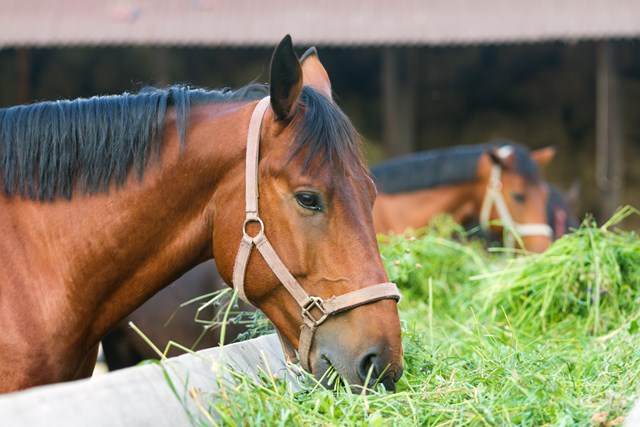By Matt McMillan, Ph. D, Equine Nutritionist, Hi-Pro Feeds
For many years, feeding oats and alfalfa hay has been a very common diet for the working and performance horse. However, with more and more research being conducted in the area of equine nutrition, the question today is “Do oats and alfalfa hay meet all the nutrient requirements under all stages of life and level of activity for my horse?”
Good quality alfalfa hay is one of the most palatable and digestible forage sources that can be offered to any class of horse. When an alfalfa crop is properly cared for, baled, and stored, the high leaf to stem ratio can provide a very high quality forage product. When considering plant structure, alfalfa, which is considered a legume, has an advantage over grass hays simply because of the plant makeup. In general, legumes are typically more digestible than grass hay sources. Also, alfalfa hay generally provides a high content of digestible protein along with quality sources of energy, Calcium, Magnesium, and Vitamin A.
Many years ago, oats were introduced in to the horses diet. This was due to the observation that when horses were fed oats along with good quality forage, they could perform tasks for longer periods of time. This meant that forage alone was not meeting the energy requirements for the horses to perform certain tasks. It was found that oats were a safe and dependable way of providing additional energy so that work by the horse could be extended and more tasks could be achieved in a day. This was very important because at the time, everyday life depended on the use of a horse including both work and pleasure.
So, the question once again is ‘Are oats and alfalfa hay the best diet for my horse?’ We do know that we can increase the horses energy levels by adding oats to the diet, but the real question is, ‘Are we meeting all the nutrient requirements?’ Is it possible to include additional nutrients in the diet to further increase the performance and help to decrease the chances of injury and/or pre-mature breakdown? The evolution of equine nutrition research reveals that the answer to this question is ‘YES’. While oats do provide additional energy to the diet, there are actually some downfalls to a standard oats and alfalfa hay diet.
While oats are considered a safe grain source that provides additional energy in the horse’s diet, other factors need to be considered when trying to meet all the nutrient requirements according to stage of life and level of activity of the horse. In a typical oats and alfalfa hay diet, energy, protein, Calcium, Phosphorus, Magnesium, and Vitamin A requirements will generally be met. However, Copper, Zinc, Manganese, Selenium and Vitamin E will likely not be met. So, is this a problem, and if so, why?
Copper is a key element in the development and maintenance of soft connective tissue including cartilage. This makes the presence of Copper in the diet especially important in the growth and development of the young horse. Some studies have shown that Copper deficiency may lead to the development of lower leg deformities and lamenesses including developmental orthopedic disease. Other important aspects of proper Copper levels in the diet include: hemoglobin formation, nerve conductivity and coordination, production of energy in the body from feed sources, hair and skin development, and antioxidant properties.
Zinc is present in the body as a component of more than 100 enzymes. Without the presence of Zinc, many necessary reactions that take place in the body cannot occur because these enzymes cannot be formed. When this occurs, growth rates can be reduced, skeletal problems may occur, hoof, skin, and hair development can be reduced, dull and lethargic appearances may occur, performance may become poor, and potentially appetite can be reduced or even cease.
Manganese is essential for carbohydrate and fat metabolism. It is also extremely important in the synthesis of chondroitin sulfate which is necessary in cartilage formation. Further, it is also important in bone formation as well as energy utilization in the body. Deficiencies include lethargic, dull appearance, reduced performance, and abnormal cartilage and bone development.
Selenium and Vitamin E work along side one another in the body to provide a cellular antioxidant defense system. In young horses, deficiencies can lead to weakness, impaired locomotion, difficulty in suckling and swallowing, respiratory distress, and impaired cardiac function. In older horses, Selenium and Vitamin E deficiency can lead to muscle fatigue. In mild cases, signs of deficiency may include poor performance as well as potential stumbling. In extreme cases, tying-up may occur.
So, while a traditional oats and alfalfa hay diet can increase the additional energy requirements needed to perform certain working tasks, not all nutrient requirements will be met. In extreme cases of deficiencies, problems may possibly be irreversible and potentially fatal. More commonly however, are the cases by which are considered to be sub-clinical, which means that they are not readily observable. If the horse is slightly deficient in its nutrient uptake on a daily basis, eventually some type of breakdown will occur whether it be related to growth and/or performance. Therefore, it is wise to either feed a good fortified feed along with a high quality forage source or at the very least provide an additional vitamin/mineral source so that we can be certain that all the nutrient requirements are being met.
To find a full line of high quality fortified horse feeds visit our product page or check out our customized ration wizard. The Microsteed program will provide specific feed recommendations based on the horse’s weight, stage of life, level of activity, and pasture availability.


